Before we talk about how to overwinter banana plants, the first thing we need to get straight is that the banana tree (Musa spp.) is not actually a tree. It’s an herb! A rather sizeable herb.
Its “trunk” is actually a cylinder of tightly layered leaves called a pseudostem.

We link to vendors to help you find relevant products. If you buy from one of our links, we may earn a commission.
The banana is an attractive herbaceous flowering plant that grows to a mature height of 12 to 18 feet tall. Its large leaves, purple flowers, and brightly colored fruit make a dramatic statement in the garden.
How to Overwinter Your Banana Tree
It’s a Tropical Plant
There are about 70 species of the genus Musa, and they are indigenous to tropical areas of India, Southeast Asia, and northern Australia.
They are now grown in more than 135 countries, mostly for their fruit, which is enjoyed around the world.
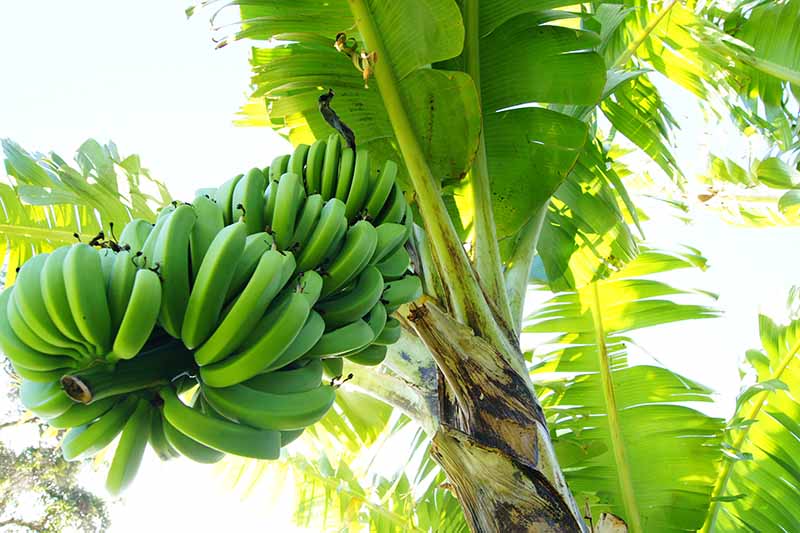
Given their native climate, it is unsurprising that banana plants are cold intolerant. They need mild temperatures in order to grow; their leaves will stop growing at around 55°F.
They will suffer leaf damage at 32°F, and their underground rhizomes will die at sustained temperatures of 22°F or lower.
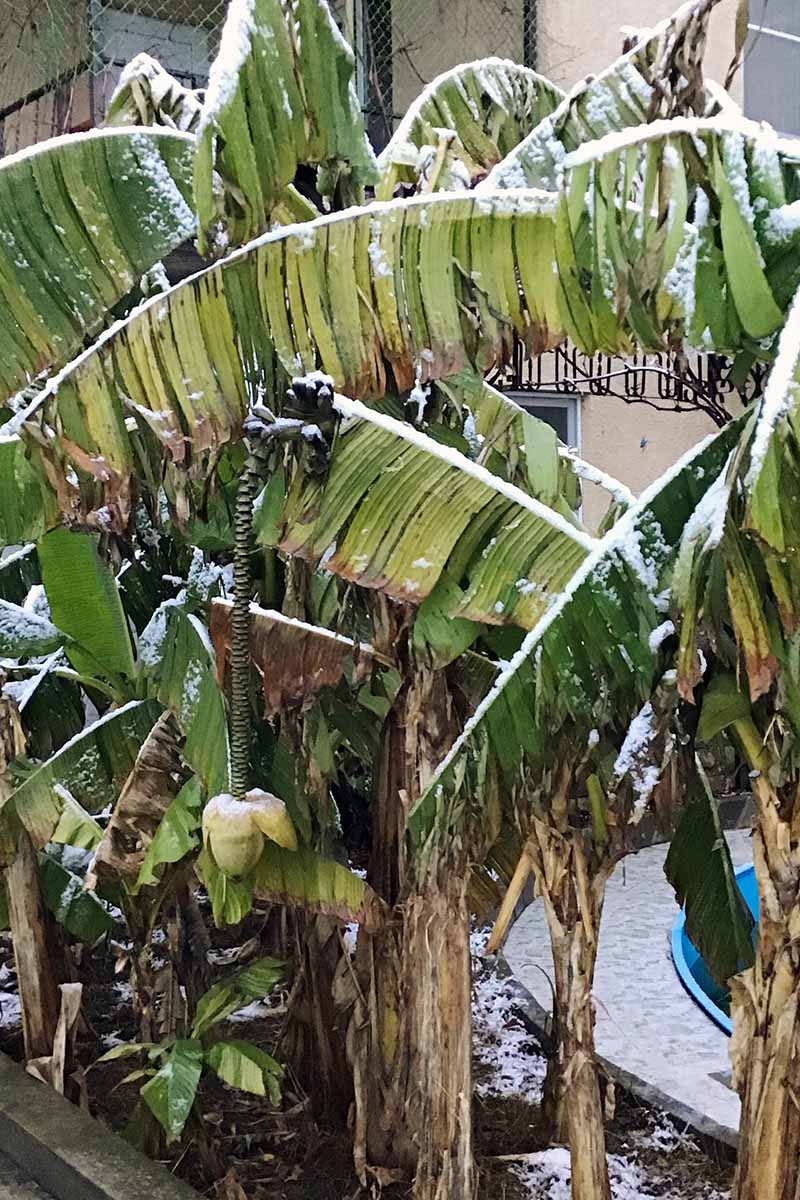
Having said that, we would be remiss if we didn’t mention that there are indeed a few cold-tolerant varieties available.
For example, the ‘Japanese Fiber’ variety (M. basjoo) can withstand sub-zero temperatures. It’s hardy to Zone 5 or 6, and can be overwintered in colder areas by cutting it back and providing a protective mulch around the stem.
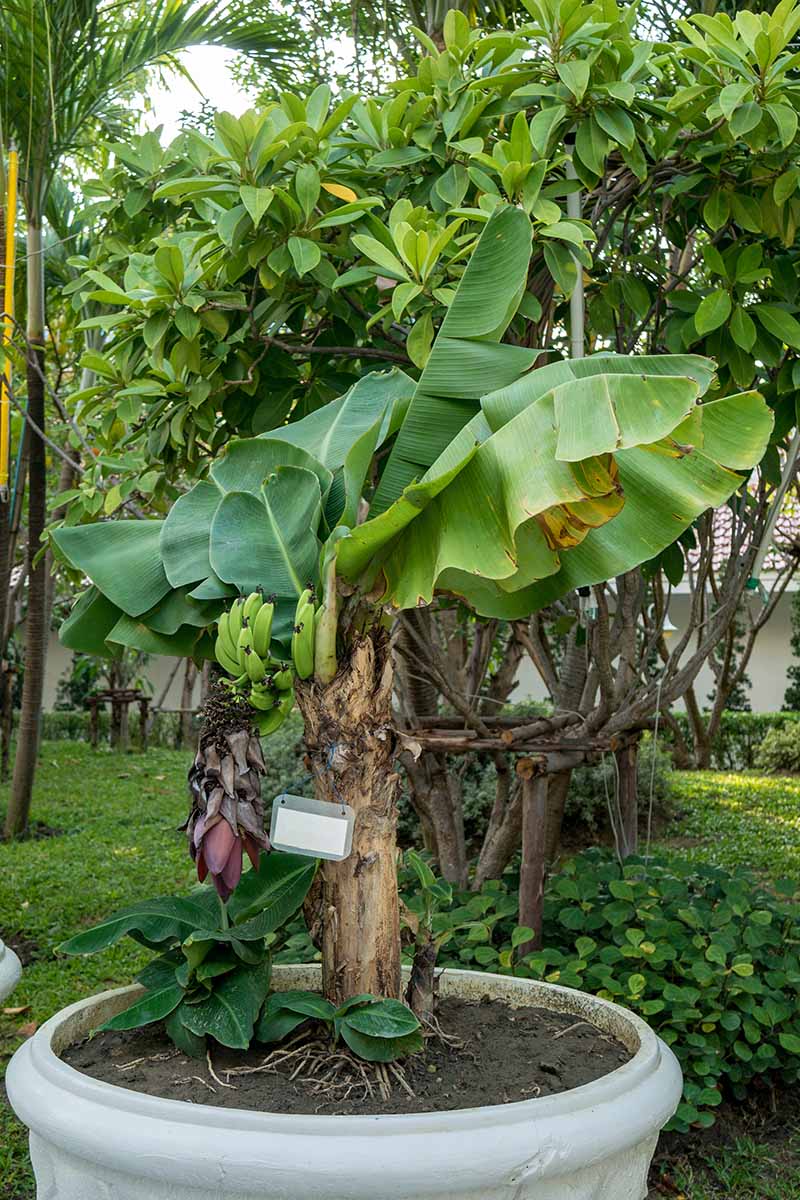
Nevertheless, most banana plants like it hot, and if you don’t live in USDA Hardiness Zone 9 or higher, you may wonder how you can add one of these tropical beauties to your landscape and keep it alive over winter.
Let’s learn more!
Keeping Your Banana Plant Alive
Here, we’ll offer three ways you can protect and preserve your banana plant over the winter months:
Container Growing
Perhaps the most obvious way to successfully overwinter a banana tree is to grow it in a container and bring it indoors when temperatures drop.
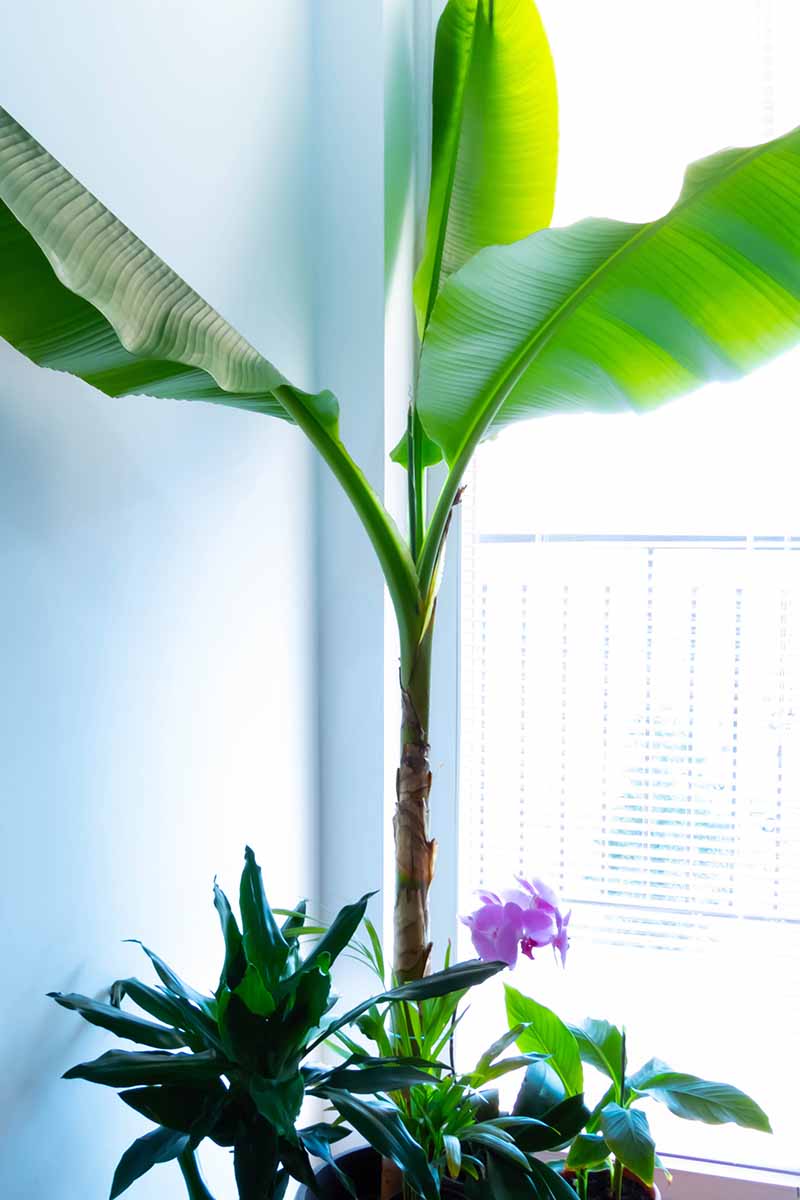
It is best to select a dwarf variety for container growing. A 15-foot “tree” in a pot would be a bit unwieldy!
Simply enjoy your potted plant on the patio or deck all summer, and then bring it indoors when outdoor temperatures begin to drop.
You have a couple options in terms of where you place it indoors.
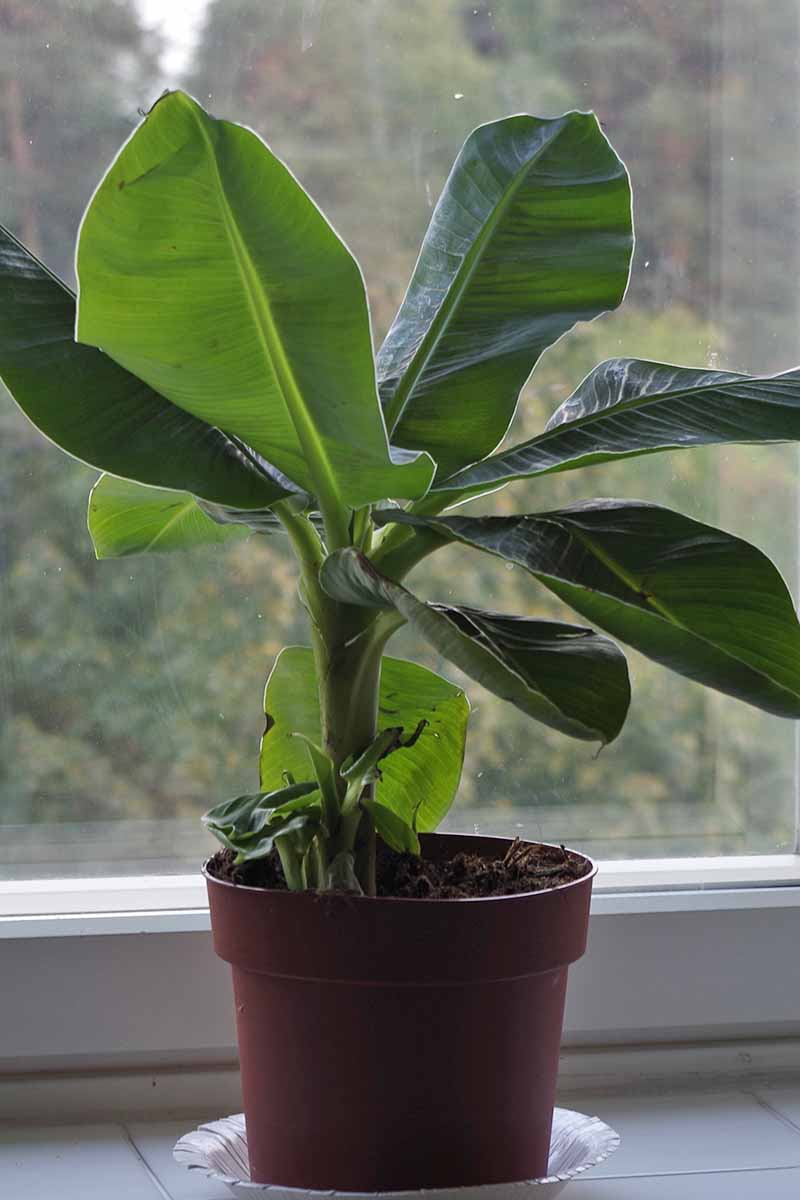
If you’d like to adorn an empty corner of your living room, make sure it’s a sunny spot and be sure to keep the soil moist, but not soggy.
Provide humidity by misting the leaves via a squirt bottle filled with water.
Expect to see slow growth during this period.
If an attached garage or crawl space makes more sense for overwintering your container grown banana, begin preparing the plant by gradually reducing irrigation as the weather cools.
Before the first frost, cut the stem back to about six inches tall, and place it in a cool, dark place – approximately 40-50°F.
Water just enough so that the soil doesn’t separate from the sides of the container.
It will go dormant through the cold months, and you can take it outdoors again and start watering it properly once temperatures start to climb and all risk of frost has passed.
Cover It
If your plant is growing in the ground, one option for safely overwintering it is to protect it with thick layers of mulch.
The goal here is to protect the large rhizome at the base of the pseudostem, which is known as the “corm.” The corm has several growing points that will sprout new rhizomes – or “pups” – which can be transplanted.

Cut the plant back to about 4-6 inches above the ground, and then pile on at least a foot of leaves, straw, or other mulching material.
You might also cover the pile with plastic sheeting, row cover material, or a cloche for more protection, and to keep the mulch in place.
If you can’t bear to cut your plant down, you can leave it intact and fashion a wire cage around the pseudostem, leaving one to two feet of horizontal clearance from the stem to the cage.
Make the cage as high as the amount of pseudostem you want to protect.
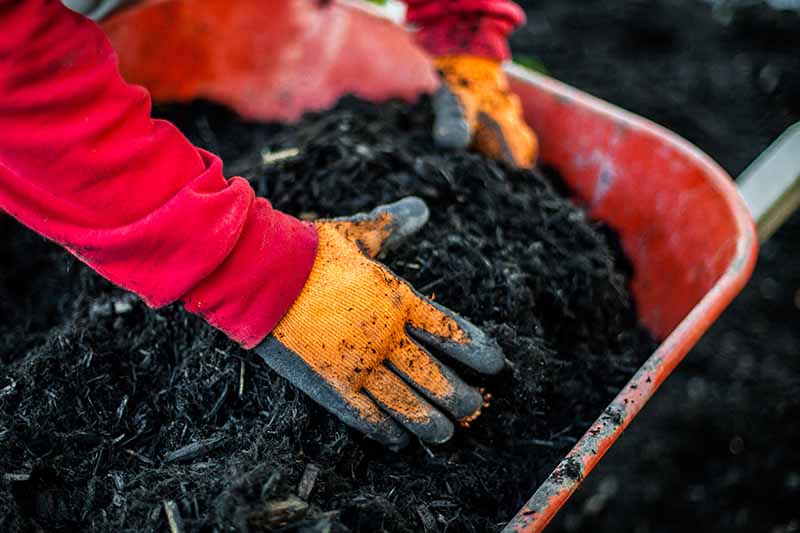
After the first light frost, fill the cage with shredded leaves or straw. Make sure you pack it in well, so it completely surrounds the stem.
You may lose any portion of the plant that sticks out above the cage, but the covered portions and the rhizome underground should be protected.
You can also wrap hessian or row cover material around the outside of the wire cage to add insulation and keep the material in place.
Remove the cage and mulching material when warm weather returns and the plant shows signs of regrowth.
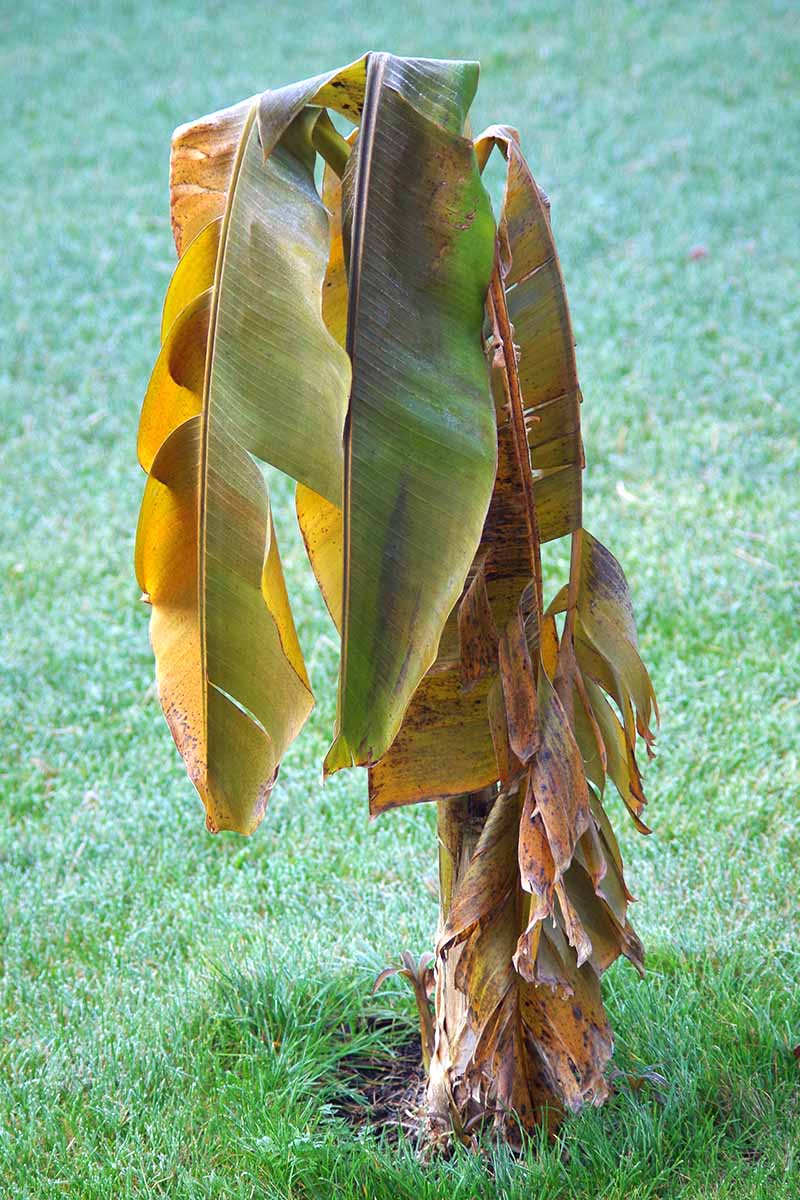
Trim off any dead material and start watering.
You can spread the shredded leaves or straw around the base of the plant to provide some extra organic material to the soil.
Dig It Up
Another way to protect your banana plant during wintertime is to dig it up and move it to a cellar, crawlspace, or similar area where the temperature is consistently 45-50°F. Ideally, this should be done before the first frost.
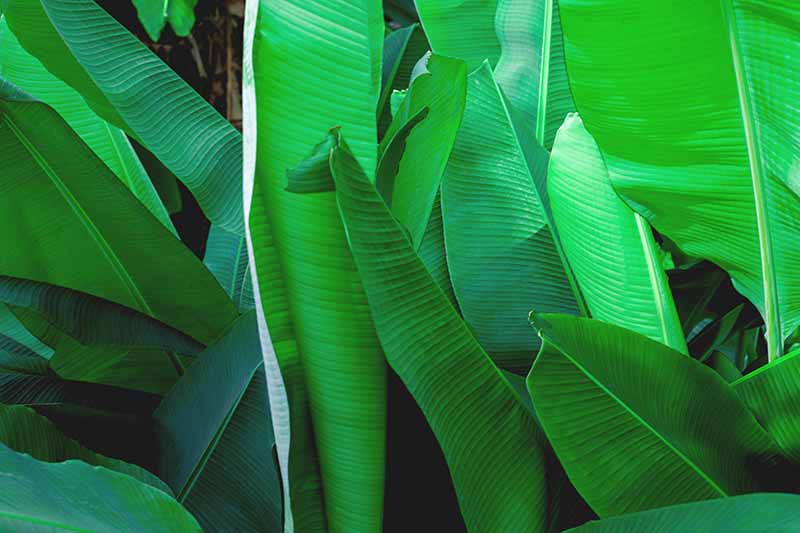
Before you start moving earth, though, you’ll want to cut the plant back to about six inches tall. When that’s done, carefully dig out the rhizomes and roots. Make sure you dig out at least 6-8 inches on either side of the base of the stem.
Place the root ball in a container of slightly moist sand. The tree will go dormant so it won’t need light, and you shouldn’t water it at all during this time.
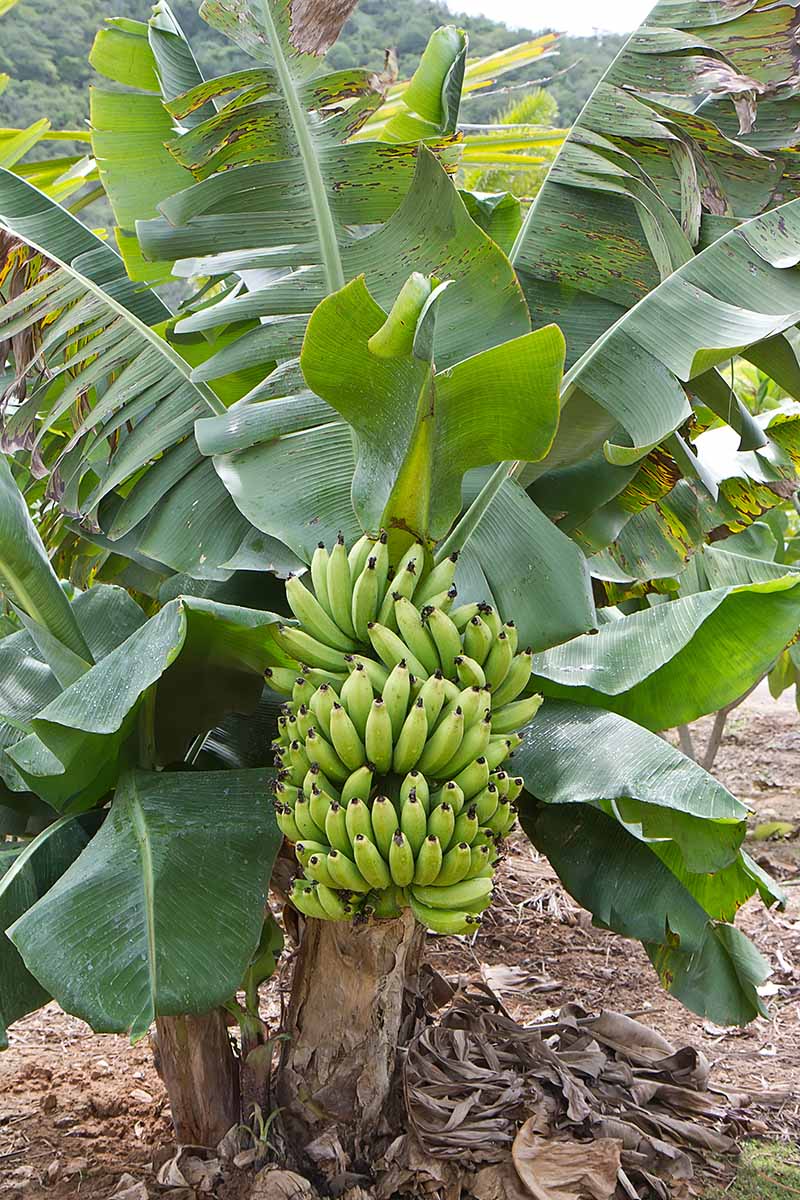
Banana trees with pseudostems that are larger than five inches in diameter can be dug up and stored without lopping off the top first. Shake the soil from the roots and lay the plant on its side on top of a tarp or newspaper in your chosen location.
Replant when all danger of frost has passed. You’ll want to give your tree plenty of water to revive it.
A Statement Plant that Deserves a Second Life
With their large leaves and impressive height, banana plants can make a spectacular statement in the landscape. But for most of us in the United States, the beauty fades when the winter’s chill approaches.
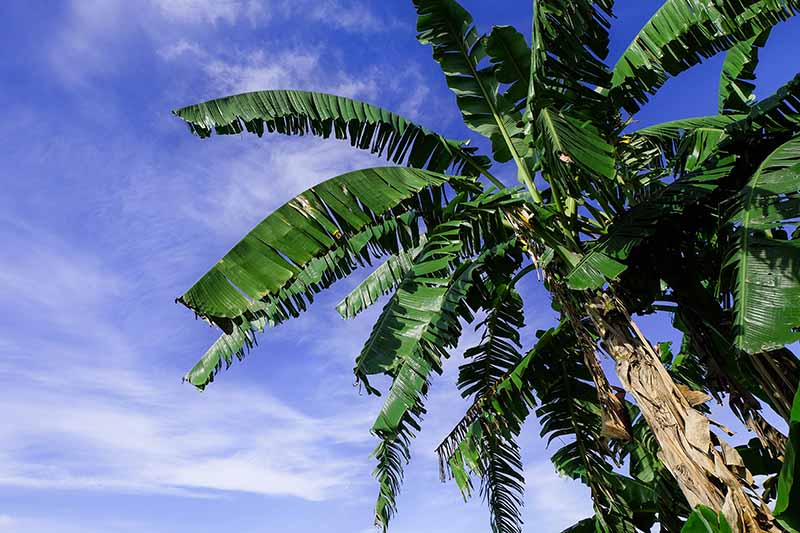
Rather than simply abandoning your bananas to the whims of weather, you have several choices for protecting them for a return engagement come springtime.
Have you successfully overwintered one of these tropical beauties? How do you revive them after winter? Share your tips in the comments section below.
Do you have other plants you need to protect from the cold? Check out these guides:
- Guide to Clematis Winter Care: Protect Your Vines From Freezing and Frost
- Lemongrass Winter Care: How to Prepare for the Cold
- How to Protect Rosemary Plants in the Winter
- How to Prepare Fruit Trees for Winter
© Ask the Experts, LLC. ALL RIGHTS RESERVED. See our TOS for more details. Uncredited photos: Shutterstock.


Bananas are very forgiving with the right care. After fruiting , cut down stem close to ground to allow energy to feed new growth.
And after you have 3 new sprouts you can remove one sprout and pot it up to make new planting.
This first cold snap has me looking at my banana plants, several, keiki/baby trees have successfully started. Main plants around 6 feet, babies between 1 and 3 feet
Should I cut the babies and the main stalk? I really don’t think we will have sustained freezing temps here, in the New Braunfels area. Any thoughts?
Are you referring to New Braunfels, TX? In Zone 8b, you’re right that a sustained freeze isn’t likely, but temperatures do often drop below freezing in the winter. I’m not sure which type you are growing, but keep in mind that bananas are semi-tropical/tropical plants. Cutting them back is generally recommended to preserve their health through the winter, and I would plan to mulch them well for extra protection. Any foliage left on the plant can suffer frost damage.
Living in NY ,I’ve been digging up my banana tres every year. This is the first year I will attempt mulching them over. I have about 10 bags of mulch and a frost blanket. Wish me luck!
Hi Frank, good luck.. Let us know how it goes! 🙂
Did this work? In PA and thinking of trying the same thing.
Hi Frank! As a fellow NYer, so curious to hear a bit more about what you do with the plants you dig up. I’ve got a musella lasiocarpa and a dwarf lady finger and am trying to figure out what to do with them this winter. Any insight would be really appreciated!
We just moved into a new house in October and we have (had) a beautiful banana tree is about 15-20 ft tall. We had no idea how to care for it (living in North Carolina) and with everything going on we forgot to care for it during the winter. Of course all the big leaves are dead and we are trying to figure out now, what should we do? Is it ok to just cut the dead leaves off and than wait for the spring? Any other suggestions?
Cut it back to about 1’ off the ground . Cover with mulch inside a used plastic plant container. Cover loosely with burlap. Put stone on top of burlap. In early Spring… remove. This works great.
Also, cut at 45 degree angle.
I see a lot of people are still getting a banana plant and a banana tree mixed up. They are totally different. The plant will get about 10 maybe 12 feet tall and bears no fruit whereas the tree can get as tall as 25 to 30 feet with – you guessed it – bananas. But I was wondering how far out from the trunk a pup will sprout. And if I put large flat rocks or stones around the stalk if that will keep them from coming thru the surface.
They are one and the same. Banana basjoo grown in a pot in a colder region will likely not bear fruit. Musa basjoo grown in the ground in the proper region with a proper growing season will bear fruit.I’ve seen large potted basjoo in a nursery in Wisconsin bearing fruit in a greenhouse. Same plant, different climates will have differing results. Typically a potted musa basjoo will not bear fruit or at least will not bear edible fruit.
I meant to say musa basjoo not banana basjoo.
Got it! Thanks for reading and commenting.
Hello Wlkim, I agree that M. basjoo can produce fruit, even indoors, though it is not that likely unless you grow it year-round in a greenhouse where it’s warm and you never let (or encourage) it to go dormant.
Thanks for clarifying.
I dug up my Banana tree, Ensete Maurelii, about this time last year. I whacked it down to about 8″ tall, squirted the dirt off the roots, let it dry off. I put it into a brown paper grocery bag and put it into a dark closet in the basement. I told it to be dormant. Sometimes it sent up white stalks. I cut those off and when things warmed up this past spring, I planted it. It has been VERY happy this year on the south side of the house. It doubled in height and circumference. I dug it… Read more »
I have my whole back fenced lined with banana palms, they are beautiful. Before first frost I cut them back to about a foot to 2′ tall and then covered them with a straw, or hay. My plants are way to big to dig up. Also when it gets really cold I will cover them with burlap. In the spring they come back really fast and healthy! Love theses palms!!
Hello Suzanne Sherburn. That sounds like a worthy approach and I’m so glad you’re having success with it! Thanks for sharing your tips.
My back fence is lined with them also I do exactly the same thing in winter, I’m in central California I tried attaching a picture wouldn’t work!
Sorry the photo didn’t come through, Suzanne Sherburn. The back fence lined with bananas grown outdoors all year long sounds splendid.
It would be helpful to know where you live I.e. your climate. In Wisconsin I’m not so sure this would work with our brutal winters.
Agreed, Wlkim, what works in Central California, where the hardiness Zone is somewhere between 8-10, will not work in frigid Wisconsin, which ranges from Zone 3-5. You’d have to bring a banana plant indoors for much of the fall and all of the winter. Good luck if you’re getting ready to attempt winterizing a banana plant.,
I live in the UK, I have a hardy Japanese (Musa Basjoo) and a red Abysinnian Banana plant which i’ve overwintered for the first time. It has not been too cold here over winter (I have them in a sheltered garden) but it has been wet. I havent brought the plants inside or cut them down at the stem (I couldn’t bare to) but I did protect them with hessian wrapping, packed straw inside a frame of chicken wire and covered the top with plastic sheeting. However, when i’ve opened them up both stems are very wet and a bit… Read more »
Hello Lawrence. I would give it another go with pruning them before trying to wrap them to overwinter.
It’s wrenching to have to cut them back, but also an essential part of the overwintering process.
If you’re able to attach a photo or two, I’d like to get a look at what’s going on and offer some further advice. But I’m fairly certain the wet stems are reacting poorly because they should have been trimmed.
Good luck with the overwintering. Banana plants are so appealing and easy to love.
Mine’s in a pot, it’s only a small baby. Can I bring it inside over winter?
Yes, you can! See the container overwintering section in the article above, and please let us know if you have any specific questions. Good luck!
How cold can they get? We’ve had 39 degrees (Middle Tennessee, zone 7a) and will again tonight with a little more warmer weather coming after this but I won’t have opportunity to dig for 3 more days. Will this cold snap ruin anything I might try to save? I’m really not certain what I have. I bought one plant about 10 years ago & now I have at least a half dozen every year.
What a wonderful addition to the garden! Have you cut the plants back? As noted above, bananas will suffer frost damage at temperature below freezing, and the rhizomes cannot withstand sustained temperatures at or below 22°F. Covering them with a thick layer of mulch for protection until you’re ready to move them may be a good idea.
I was hoping I could still dig up the entire plant a store in a cool location. Lows are supposed to be 45 & above for the next week or so.
Absolutely- digging it up ASAP for storage is your best option.